Voit J. The Statistical Mechanics of Financial Markets
Подождите немного. Документ загружается.

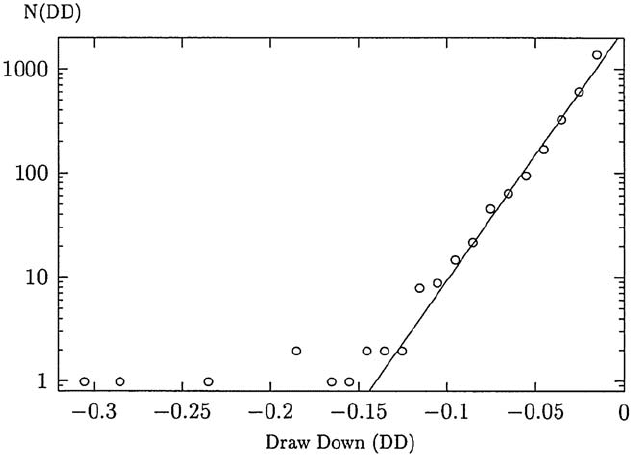
262 9. Theory of Stock Exchange Crashes
to the decline of the DAX over the entire four month Russian debt crisis
period in autumn 1998! This was the largest crash of the century.
3. Other important crashes took place in 1929, and at the outbreak of World
War 1. Figure 9.3 shows the largest weekly drawdowns of the Dow Jones
in this century. The biggest crash was 1987, followed by World War 1,
and the 1929 crash. Notice that on this scale, the Asian and Russian
crisis are completely negligible, and contribute to the leftmost points in
this figure. (Of course, they are no longer negligible when the variations
of the Asian or Moscow stock exchanges are plotted.)
Figure 9.3 uses an exponential distribution to fit the weekly drawdowns
of the Dow Jones index. If this procedure is endorsed, crashes would appear
as outliers: they would not be subject to the same rules as “ordinary” large
drawdowns and be governed by separate mechanisms. Indeed, this point of
view has been defended in the recent research literature by several groups,
and we will discuss it in the present chapter.
Notice, however, that the assumption of an exponential distribution is ar-
bitrary, to some extent, and that statistics is difficult on singular events such
as a major crash. In the framework of stable L´evy distributions, discussed in
Chap. 5, crashes would be part of the statistical analysis, and not be gener-
ated by exceptional mechanisms. This may also apply to power-law statistics
Fig. 9.3. Number of large negative weekly price variations of the Dow Jones in
the 20
th
century. By courtesy of D. Sornette. Reprinted from D. Sornette and A.
Johansen: Eur. Phys. J. B 1, 141 (1998),
c
1998 EDP Sciences
9.2 Examples 263
with nonstable tail exponents. Most likely, in such frameworks, crashes will
not be predictable.
Theories based on exceptional mechanisms underlying crashes therefore
can only be tested on their predictive power.
For all crashes, various economic “causes” have been discussed in the lit-
erature. Hull [10] lists a variety of such possibilities. For the 1987 crash, e.g.,
it was observed that investors moved from stocks to bonds, as the return of
bonds increased to almost 10% in summer 1987. Another cause may have
been the increasing portfolio hedging, using index options and futures, com-
bined with the implementation on computers which generated automatic sell
orders once the index fell below a certain limit. This effect has been mod-
elled explicitly in the computer simulation by Kim and Markowitz [176], cf.
Sect. 8.3.1. Changes in the US tax legislation may have contributed. Rising
inflation and trade deficits weakened the US dollar throughout 1987, and
this may have pushed overseas investors to sell US stocks. Finally, one may
think about imitation and herd behavior. However, it seems to be a common
feature of the major crashes that no single economic factor can be identified
reliably as the triggering event.
Looking at the behavior of the market operators, a crash occurs when
a synchronization of the individual actions takes place. In normal market
activity, the individual buy and sell orders are not strongly correlated, and
rather weak price or index variations result. In a crash, on the other hand,
all operators decide to sell, and there are no compensating buy orders which
would maintain market equilibrium. The market seems to behave collectively.
An increasing synchronization, or correlation, is observed in physics when
a phase transition, especially a critical point, is approached. Examples are the
transition from a paramagnet to a ferromagnet, or from an ordinary metal to
superconductivity. Certainly, there are important differences, in that crashes
take place as a function of time while the critical points in physics usually
are reached by careful fine-tuning of an external control parameter. The idea
of critical points has been generalized to self-organized critical points in open
nonequilibrium systems [79], and the question is if stock exchange crashes
can be considered as critical points, or self-organized critical points, as they
occur in physics.
There are other nonequilibrium situations in nature whose phenomenol-
ogy seems to be similar to market crashes, and where ideas and models about
phase transitions and critical points have been formalized, too: earthquakes
and material failure. We shall discuss them in the following section, before re-
turning to the (admittedly phenomenological) description of stock exchange
crashes.
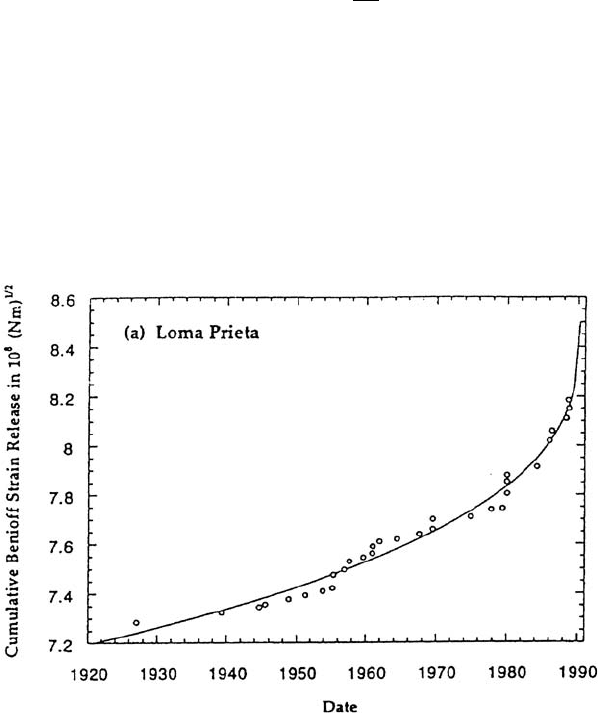
264 9. Theory of Stock Exchange Crashes
9.3 Earthquakes and Material Failure
Earthquakes and material failure are both characterized by a slow building
up of strains, and a sudden discharge. The idea of these phenomena being
critical points in time has been discussed in the literature for some time.
There is some evidence for this view, although it is still controversial.
1. Figure 9.4 shows the cumulative Benioff strain prior to the earthquake
occurring on October 18, 1989 near Loma Prieta (northern California).
The cumulative Benioff strain ε(t) is defined as
ε(t)=
N(t)
n=1
E
n
. (9.1)
n is the number of small earthquakes from some starting date t = 0 until
t,andE
n
is the energy liberated in quake n. The appearance of energy
under the square-root can simply be understood in terms of a spring
obeying Hooke’s law: at a given strain ε, the energy stored in the spring
is E =(f/2)ε
2
where f is the spring constant. Fig. 9.4 also shows a fit
of ε(t) to a power law in time-to-failure
ε(t)=A + B|t
f
− t|
µ
,A>0 ,B<0 , 0 <µ<1 . (9.2)
Fig. 9.4. Cumulative Benioff strain before the Loma Prieta earthquake in 1989
(dots) and fit to a power law (solid line). By courtesy of D. Sornette. Reprinted
from D. Sornette and C. G. Sammis: J. Phys. I (France) 5, 607 (1995),
c
1995 EDP
Sciences
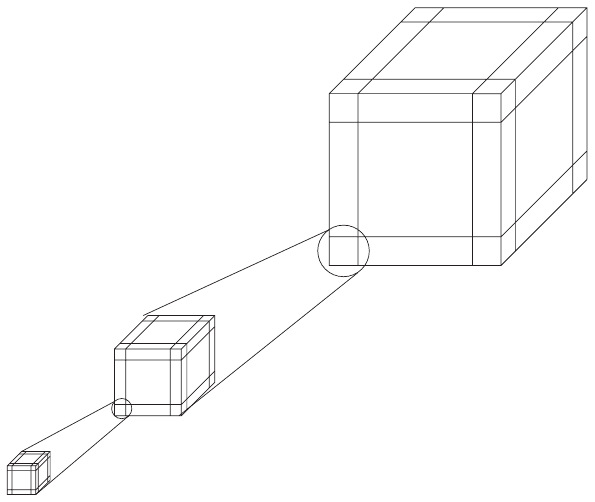
9.3 Earthquakes and Material Failure 265
Power laws are the hallmarks of critical points, and the fit apparently
supports the idea of a critical point occurring in time. Notice that ε(t)
stays finite at t
f
but dε(t)/dt →∞as t → t
f
. Notice that the deviations
between the measured points and the power-law fit do not look exactly
random. There are hints of oscillatory behavior.
2. Both the cumulative Benioff strain, and the concentration of Cl
−
ions,
before the earthquake in Kobe (Japan) on January 17, 1995, show a
similar increase [210]. Again, oscillations seem to be superposed on the
smooth power-law variation of (9.2).
3. On a laboratory scale, acoustic emissions recorded before the failure of
materials under increasing load show similar variations.
For earthquakes and material failure, models have been developed which
substantiate power-law behavior, and thus the critical point hypothesis, and
even additional oscillations as the critical point is approached. Their most
important ingredient is their hierarchical structure.
An important model for the description of earthquakes is due to All`egre
et al. [211], and pictured schematically in Fig. 9.5. One starts from a cube
formed by joining eight bars by bolts in the corners of the cube. On the next
level, eight bigger bars form a bigger cube, and eight of the small cubes of
Fig. 9.5. The All`egre model
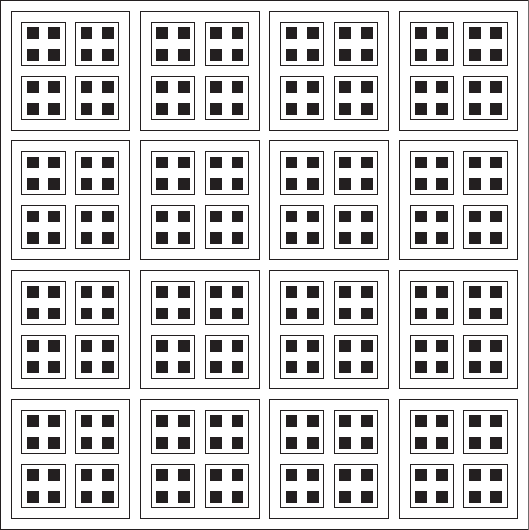
266 9. Theory of Stock Exchange Crashes
the preceding level are used as bolts to join the bars. This rule is continued
to ever larger scales. The load on the bars and bolts of the biggest cube is
distributed over all levels of the hierarchy. If this load is increased, the weakest
bolt which is on the lowest level may break. Eventually, more than one bolt
will break. This will lead to a redistribution of the load on the next level of
hierarchy, and bolts may fail there, too, either immediately, or once the load
is increased further, and so on. Finally, the highest levels of the hierarchy will
break, resulting in a catastrophic event.
Similar ideas may be invoked for the failure of materials, e.g., composed
of fibers. Figure 9.6 illustrates a hierarchical model for a fiber bundle. The
cross-section of the bundle is shown, and the fibers are oriented perpendicular
to the figure. The mechanism for failure of such a bundle under increasing
load is rather similar to that of the cubic structures of the All`egre model.
Both models show some kind of critical behavior, and power laws, as the
load on the structure is increased. Their criticality is different, however, from
the ordinary critical points of physics in one important aspect. Power laws are
related to scale invariance. Critical points associated with phase transitions
in standard physical systems (magnetism, superconductivity, etc.) exhibit
Fig. 9.6. A hierarchical model of a fiber bundle

9.3 Earthquakes and Material Failure 267
continuous scale invariance. Under a change of scale x → x
= λx,scale
invariance of a system implies that a function f (x) reproduces itself, perhaps
up to some prefactor, i.e.,
f(x)=µf(x
)=µf(λx) , (9.3)
with real λ, µ. This equation is solved by power laws,
f(x)=Cx
α
, (9.4)
which lead to the condition
λ
α
µ =1, i.e., α = −ln µ/ ln λ. (9.5)
Physically, continuous scale invariance comes out because the properties at
the phase transition are determined completely by a diverging correlation
length (the “synchronization” mentioned above), which is much larger than
typical lattice constants, or nearest-neighbor distances. Notice that the un-
derlying structures or Hamiltonians of such systems are not scale invariant,
and that scale invariance only results from the spontaneous collective behav-
ior.
As is obvious from Figs. 9.5 and 9.6, there can be no continuous scale in-
variance in hierarchical models. If they are continued to infinity, there will be
no scale on which the “microscopic” structural details can become negligible
because collective behavior would set in on much longer length scales. Un-
like the models of statistical mechanics, however, hierarchical systems have a
built-in discrete scale invariance. Under a discrete rescaling, x → x
= λ
n
x
with λ
n
= λ
n
0
, they reproduce themselves. For example, we have λ
0
=2
for the structure in Fig. 9.6. An important consequence of discrete scale in-
variance is that critical exponents can become complex [212]. These complex
exponents naturally come out of (9.5) when rewritten as
λ
α
µ =exp(2πin) , i.e., α
n
= −
ln µ
ln λ
+
2πin
ln λ
. (9.6)
A priori, any n is permissible in (9.6). However, for the usual critical phe-
nomena, solutions with n = 0 can be discarded because they would imply
the existence of typical scales in the problem, which contradicts the scale
invariance postulated to be at the origin of the power-law behavior. On a
hierarchical structure, such an objection is not possible, and complex expo-
nents must be allowed. As a consequence, when finite n are kept, a series of
log-periodic oscillations is superposed on the power-law behavior
(t
f
− t)
α
→ (t
f
− t)
α
,
1+
∞
n=1
c
n
cos
2πn
ln λ
ln |t
f
− t|
-
(9.7)
Such oscillations have indeed been observed both in earthquakes and fi-
nancial data. An important practical advantage of the modified scaling law
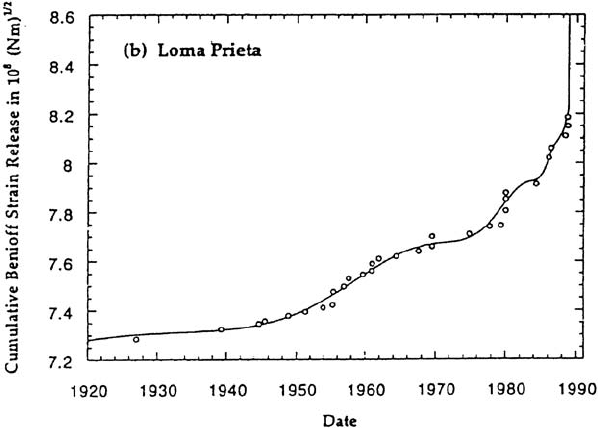
268 9. Theory of Stock Exchange Crashes
(9.7) is that the determination, and in particular, a possible prediction of
t
f
, i.e., the time to failure or to an earthquake, become much more accurate
if log-periodic oscillations lock in on the data in a fit. The disadvantage is
that the number of fit parameters to be used on a noisy data set increases
significantly, at least from four (pure power law) to seven [including the first
log-periodic oscillation, cf. (9.8) below]. Under these circumstances, there
may be many apparently equally good fits, and their interpretation as well
as the selection of a “best” fit, become a nontrivial problem [213]. Analyzing
the data in Fig. 9.4 a posteriori by fitting them to a pure power law such
as (9.2), one would “predict” the Loma Prieta earthquake to have occurred
at t
f
= 1990.3 ± 4.1. Using the first log-periodic oscillations, the prediction
becomes t
f
= 1989.9 ± 0.8, i.e., is both significantly closer to the actual date
of the earthquake, and carries a much smaller error bar. Figure 9.7 shows a
fit to the same data as in Fig. 9.4 but using log-periodic corrections, showing
the kind of agreement that can be reached. Similar fits can also be done on
Kobe data [210].
This analysis has been done after the actual earthquake occurred. What
about using the method to predict a quake? This has also been attempted
by Sornette and Sammis [213]. Figure 9.8 shows data taken up to 1995 in the
Komandorski islands, a part of the Aleutian islands in Alaska. Also shown
is a fit to (9.7) which produces a (true) prediction of a major earthquake at
Fig. 9.7. Cumulated Benioff strain prior to the Loma Prieta earthquake (dots),
fitted to a power law with log-periodic corrections (solid line). By courtesy of D. Sor-
nette. Reprinted from D. Sornette and C. G. Sammis: J. Phys. I (France) 5, 607
(1995),
c
1995 EDP Sciences
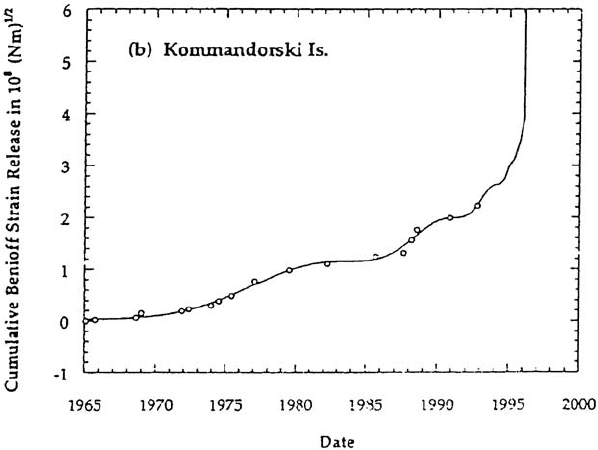
9.3 Earthquakes and Material Failure 269
Fig. 9.8. Cumulated Benioff strain released by earthquakes of magnitude 5.2 or
greater, in the Komandorski segment of the Aleutian islands (dots), and a fit to
a power law with log-periodic corrections (solid line). By courtesy of D. Sornette.
Reprinted from D. Sornette and C. G. Sammis: J. Phys. I (France) 5, 607 (1995),
c
1995 EDP Sciences
t
f
= 1996.3 ± 1.1, i.e., after the submission (January 1995) and publication
(May 1995) of the paper. This prediction is to be compared to one based on
a pure power law, (9.2), giving t
f
= 1998.8 ± 19.7, certainly too inaccurate
to be of any use. Apparently the earthquake did not happen. However, as
communicated to me by D. Sornette, from a considerably refined analysis
method, the authors of the original prediction understand that it was an
artifact of approximations used.
Earthquake predictions have also been attempted using different models,
closer to the standard lines of geophysical research [214]. One model is based
on the hypothesis that an earthquake occurs when a fault has been reloaded
with the stress which was relieved in the most recent earthquake. The time
from one earthquake to the next is the stress drop in the most recent earth-
quake divided by the fault stressing rate. It incorporates directly some of the
physical processes which are believed to be at the origin of earthquakes. This
would convey some degree of predictability to this “recurrence model”. If,
on the other hand, earthquakes occurred completely randomly, their timings
would follow a Poisson distribution.
A test of this recurrence model has been performed in one of the sup-
posedly ideal locations, Parkfield, California [215]. The town of Parkfield is

270 9. Theory of Stock Exchange Crashes
located on the San Andreas fault, one of the most seismically active regions
of the earth. At least five earthquakes of magnitude M
S
= 6 on the Richter
scale [for a definition, cf. (9.16) below], or larger, have occurred in this area
with an average interval of 22 years, the most recent one in 1966. With a pre-
diction of the next earthquake around 1988, in 1986 the US Geological Survey
set up a focused experiment to measure the stress accumulation, capture the
nucleation of the next rupture and watch it propagate. The “problem” today
is that the earthquake never arrived. In fact, the recordings of the experiment
constitute the longest documented period of quiescence at Parkfield. More-
over, using one in-situ data set and one from GPS signals, it was shown that
the stress which was released in the 1966 earthquake had recovered, at the
95% confidence level, by 1987. It continues to increase as a consequence of
continuous fault slippage. When considering a release of stress to the level
just after the 1966 quake, one now is faced with the nightmare idea that the
next major earthquake in the Parkfield region could approach magnitude 7
on the Richter scale [215].
9.4 Stock Exchange Crashes
In the initial phase of research, the basic postulate of all groups trying to
predict crashes on stock exchanges was that they work according to the same
principles as those of earthquakes, or overarching generalizations thereof.
They would view financial crashes as phase transitions in a hierarchical sys-
tem, characterized by discrete scale invariance, and being increasingly loaded
with time. However, there is no evidence for mean-reversion in stock prices
unlike the assumptions of, e.g., the recurrence model for earthquakes. More
recently, research on financial crashes has gained a momentum of its own,
and the relation to models of earthquakes has loosened somewhat [21].
Following the earthquake analogy, a stock price or index rising in time
would build up some stress in the market. It would be released in a singular
failure event, the crash, which would mark a critical point. If this hypothesis
is endorsed, the variation S(t) of a stock price, resp. index, prior to a crash
should obey
S(t)=A + B(t
f
− t)
α
{1+C cos [ω ln(t
f
− t) − φ]} (9.8)
or more complicated generalizations thereof. φ is the phase of the oscillations.
An alternative or complement to fitting this expression is to analyze the
times of occurrence t
n
of pronounced minima in the price variation which are
predicted to follow a geometric progression
t
n+1
− t
n
t
n
− t
n−1
=exp
2π
ω
< 1 . (9.9)
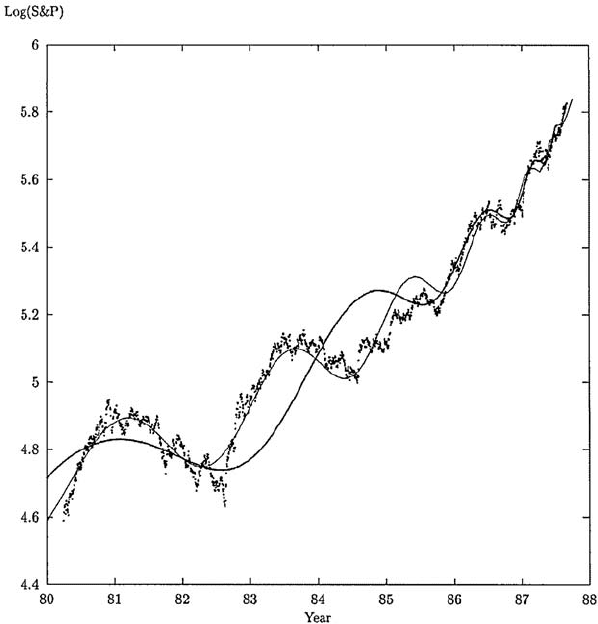
9.4 Stock Exchange Crashes 271
Fig. 9.9. S&P500 index in the seven years preceding the 1987 crash on Wall Street,
and a fit to a power law with log-periodic oscillations. By courtesy of D. Sornette.
Reprinted with permission from Elsevier Science from D. Sornette and A. Johansen:
Physica A 245, 411 (1997)
c
1997 Elsevier Science
Price histories conforming approximately to (9.8) are called log-periodic
power laws. With a positive power-law prefactor B, they correspond to bub-
bles. The understanding then is that a crash is the sudden collapse of a spec-
ulative bubble which has built up over a long time. Imitation and herding
among market participants have pushed market prices of assets significantly
above their fundamental values. The accelerating oscillations in (9.8) then
reflect the competition between the instabilities of the inflating bubble due
to sell orders on the one side, and the synchronization due to herding on the
other side.
Figure 9.9 shows a fit of (9.8) to the S&P500 index in the years preceding
the 1987 crash [216], showing clear signs of log-periodic oscillations. A similar
fit is shown in Fig. 9.10 for the 1929 crash, using the Dow Jones index [216].
While these fits apparently describe the large-scale evolution of the data quite
